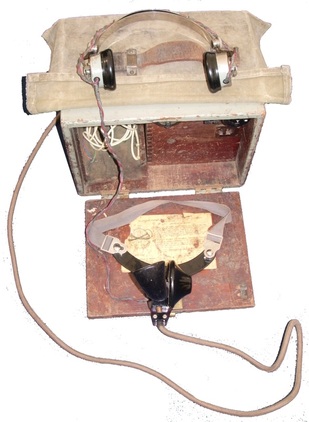OBSERVER POST TELEPHONE

Early model AD163 Post Telehone
.The early Observer Corps post telephones were hand cranked "magneto" telephones which were linked directly through to the Observer Centre via the telephone line network. The phones operated by turning an handle which generated a (relatively) high voltage alternating signal in order to ring the bells of other telephones on the same line and to alert the operator. The telephone were used with a head and breast set that was worn by the observer.
There were two main post telephones. The initial post telephone was designated - AD163. This formed the basis of the post telephone for the Observer Corps. Of this type there were three initial production runs 'A', 'B' and 'C'. These were designated as AD163, AD163B and AD163C.
The impact of the War led to the redesigning of the post telephone in light of the need to increase the speed of production and limited access to resources that were required for the war effort. This led to the use of cheaper and more accessible resources in which to manufacture the telephones. Internally these "economy" post telephones; which were designated - AD1542, were identical. The only major change was the use of different wood in its construction which was vastly different; being smaller, using butt joints and nails instead of dovetail joints and powered by slightly different batteries. The metal hardware used for access and hinges was also simplified but achieved their purpose during the wartime period of materials shortages.
The telephone units were manufactured by the GPO at one of two factories within the UK that the GPO had at the time.
- London Holloway: This site was designated 'FH'
- Birmingham: This site was designated 'FB'
The post telephones were in operation through the war years and into the Cold War underground period until finally being phased out in the late 1950s' / early 1960s due to the introduction of the introduction of the more technically advanced AD3460 ‘teletalk’.
(Note: By 1971 the GPO had four factories for the construction of general GPO equipment. Two other factories were located at Edinburgh designated FNB and Cwncarn in Wales designated FW.. For further information of GPO factories then please check out this link ... www.lightstraw.uk/ate/facd/index.html)
There were two main post telephones. The initial post telephone was designated - AD163. This formed the basis of the post telephone for the Observer Corps. Of this type there were three initial production runs 'A', 'B' and 'C'. These were designated as AD163, AD163B and AD163C.
The impact of the War led to the redesigning of the post telephone in light of the need to increase the speed of production and limited access to resources that were required for the war effort. This led to the use of cheaper and more accessible resources in which to manufacture the telephones. Internally these "economy" post telephones; which were designated - AD1542, were identical. The only major change was the use of different wood in its construction which was vastly different; being smaller, using butt joints and nails instead of dovetail joints and powered by slightly different batteries. The metal hardware used for access and hinges was also simplified but achieved their purpose during the wartime period of materials shortages.
The telephone units were manufactured by the GPO at one of two factories within the UK that the GPO had at the time.
- London Holloway: This site was designated 'FH'
- Birmingham: This site was designated 'FB'
The post telephones were in operation through the war years and into the Cold War underground period until finally being phased out in the late 1950s' / early 1960s due to the introduction of the introduction of the more technically advanced AD3460 ‘teletalk’.
(Note: By 1971 the GPO had four factories for the construction of general GPO equipment. Two other factories were located at Edinburgh designated FNB and Cwncarn in Wales designated FW.. For further information of GPO factories then please check out this link ... www.lightstraw.uk/ate/facd/index.html)